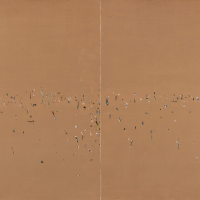16. FRED WILLIAMS

In 1968 there was a revolutionary uprising in Paris, the Russian tanks rolled into Prague, Martin Luther King and Bobby Kennedy were assassinated, and the National Gallery of Victoria opened its new building on St Kilda Road. It may sound like we had a quiet time of it, but the gallerys inaugural exhibition would have radical implications for Australian art.
That show, The Field, was devoted to a group of younger artists working in the contemporary cutting-edge styles of Hard-edge Abstraction, Minimalism, Colour Field, and Conceptual Art. It was a provocative gesture that thrilled some viewers and alienated others. For the established artists of Fred Williams generation, it was profoundly depressing to be snubbed in favour of a group of newcomers devoted to an international style that found its Mecca in New York, and its prophet in art critic Clement Greenberg.
Williams was by no means an enemy of the work in The Field. He watched all new developments keenly and kept an open mind. As with many of the best artists, he didnt draw hard-and-fast distinctions between abstraction and figuration. The great works of figurative art were full of abstract devices, while many abstract works found their inspiration in landscape.
Williams had done more than anyone to restore the prestige of Australian landscape painting which had fallen into clich and become anathema to local would-be modernists. On his return from England in 1956, Williams shocked his friend, John Brack, by declaring that he was going to paint the gum tree.1 He would be as good as his word, but Williams gum trees were not of the same family as Hans Heysens.
In a little more than a decade of unstinting work, Williams had reinvented Australian landscape painting, not just once but several times over. The progression across series from his Mittagong works to his You Yangs, Upwey and Lysterfield paintings, revealed an artist working at the peak of his powers. He had every right to expect to be part of an opening display in his home city. It wasnt however, the first time Williams had been rejected from a major exhibition. He may have been too figurative for The Field, but Bernard Smith had seen his work as too abstract for the Antipodeans show of 1956.
The Australian Landscape series has often been interpreted as Williams response to the new abstraction. While still recognisably landscapes, these works are minimalist in inspiration. The idea behind them, however, was a sweeping one. They represented a distillation of the vastness and emptiness of the outback, traits that could so easily expand to engulf the entire continent. The paintings were the culmination of Williams growing intuition that despite superficial differences, there was a common element to all parts of Australia. He would refer to the series as landscape with the skin taken off.2
Although these works became Williams closest approach to pure abstraction, allowing some to believe he was following a natural aesthetic progression, he was never tempted to abandon landscape altogether. His direct source of inspiration was relatively prosaic: the experience of looking down on the earth from a plane. The vertical lines that divide these works into panels refer to the fences that stretch for so many kilometres in more remote regions.
It was a standard procedure for Williams to run two strands of wire diagonally across a canvas to provide a loose structure for a collection of marks that had a random appearance but an underlying sense of correctness. Rarely, though, would he divide an entire work into symmetrical panels, as he does with Australian Landscape I. It suggests a certain anxiety that this experimental painting should be viewed as a composition, not a spontaneous scattering of flecks of colour on a flat field.
The series designates an endpoint in Williams work, as the furthest he would reach in painting the landscape with an absolute economy of means. From here on his work would become more painterly, and presumably more in line with his creative instincts. In a picture such as Silver and Grey 1969, one finds the same flat, unmodulated backdrop, but a much more expressive application of paint, and the bare suggestion of a horizon line. The high aerial perspective has been abandoned. The artist is back on solid ground, facing his motif. Over the following decade Williams landscapes would become more naturalistic, incorporating a bolder use of colour.
In retrospect, the Australian Landscapes are among the most original works painted in this country at a time when local artists were heavily influenced by the latest developments in international art. Although Williams could not deny the strength of this attraction, especially when the National Gallery of Victoria had endorsed the new movements so wholeheartedly, neither could he sacrifice his commitment to landscape painting and conform to the dictates of fashion. His solution to this dilemma testifies to his originality, his determination to find his own path when the avant-garde compass seemed to point in only one direction.
Footnotes:
1. Fred Williams, quoted in Hart, D., Fred Williams: Infinite Horizons, National Gallery of Australia, Canberra, 2011, p.45
2. Fred Williams, quoted in McCaughey, P., Fred Williams 1927-1982, Murdoch Books, Sydney, 2008 (revised edition), p.216
John McDonald
John McDonald is the author of Jeffrey Smart: Paintings of the 70s and 80s. He writes a weekly art column for the Sydney Morning Herald and a weekly film column for the Australian Financial Review.